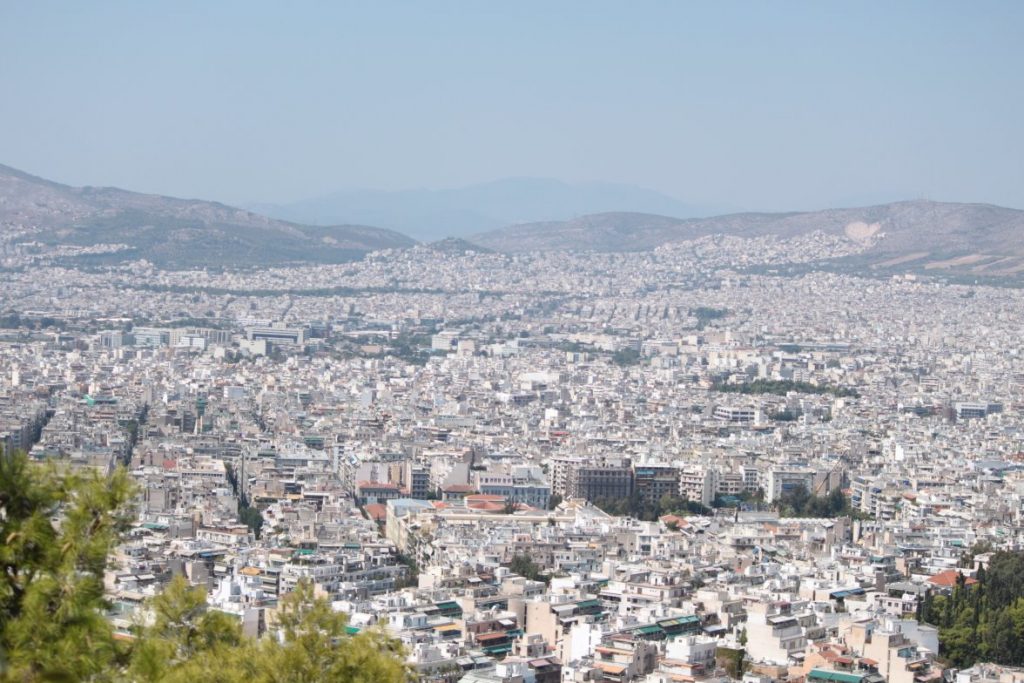Our day in Athens was interesting. Rather than take one of the standard half-day city tours we decided to hire the taxi driver who brought us in from airport yesterday to drive us around for several hours. He—George Stathis—isn’t a tour guide but he did a good job of taking us to places we wanted to see. [lots of pictures at Pictures]
Patricia and I started early. We were eating breakfast outside at 6:30 this morning. The temperature was good and we were able to see the sun illuminate the Acropolis and the hillside houses as it rose. The air quality isn’t great here, but it is better than in some cities.
We started our tour early and were able to beat some of the tourists to the Acropolis.
George drove us to a drop-off point and we hiked up the hill and into the complex. One thing we had read about and experienced firsthand was how slippery the paths were. Over many, many years visitors have worn the rocks and paths in some places into a smoothness that was sometimes like an ice-skating rink. Although we know what the Parthenon was/is, seeing it personally brought home a different reality. For one thing, it is big. Its scale is immense. Some of the pictures we took have people in them so you may be able to get an idea of size.
Close by is the Erechtheion, which was the most important temple in the complex because it is where Athena supposedly planted the sacred olive tree. There are many columns in the Parthenon and the Erechtheion and there is an optical illusion that the columns bulge, but they don’t. The guide book says that part of the design of the Parthenon is that there are no straight lines. I expect that what it means is that the columns and other components don’t line up exactly because I thought I saw lots of straight lines. Several of the temples here were built in the 5th century B.C., but I learned today that the Beulé Gates were part of the Roman fortifications of the area. We also saw a small theater dedicated to Dionysos that is used for concerts today. It seats 5,000 people and some of the pictures show workers setting up for a concert.
Because the Acropolis is so high (about 350 feet) we had a good view of Athens. We could see the temple of the Olympian Zeus, which is where we drove next. At this site the temple one had 104 columns. On-and-off construction took almost 300 years and the building was actually finished by the Romans. The 16 remaining columns are magnificent in their isolation.
We made a quick stop to see the changing of the guard in front of the President’s official residence. It wasn’t on the scale of the changing of the guard at Buckingham Palace by any measure, but it was fun to see. I have a movie of some of it that I will post to YouTube when I get a chance
George took us on a drive through the curved and haphazard streets of the old part of Athens, something we would never have been able to do in a bus. There seems to be a complete disregard for any kind of order about where to park in this city, which means that streets become clogged very quickly.
We drove up Lycabettus Hill, which is the highest point in the city for a final overlook of the valley. We learned that until just after the end of World War II, Athens was a “paradise” (according to George) until lots of newcomers came in and filled up all the available space.
We spent about five hours on this sightseeing drive with a very interesting and informative man who has lived here nearly all of his life and has driven a cab here for 27 years. In addition to seeing some of the sights in a unique way, we learned a great deal about everyday life in Athens. We certainly did not see everything (for example, Patricia and I somehow walked past the ancient Agora while we were on our own) but we had a very nice introduction to this important city.



